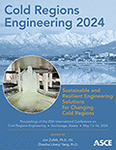Different Active Thaw Protocols for High Ice-Content Permafrost Layer: A Laboratory and Site Study
Publication: Cold Regions Engineering 2024: Sustainable and Resilient Engineering Solutions for Changing Cold Regions
ABSTRACT
With global warming, engineering measures based on permafrost protection are still challenging to inhibit high ice-content permafrost thawing and subsidence in some areas of the Qinghai–Tibetan Plateau (QTP). Hence, early permafrost thawing is an effective method to reduce the later settlement of the upper infrastructure. In this study, thawing tests were carried out on permafrost using steam and heater tubes in the laboratory and on-site, respectively. The results show that steam can rapidly melt frozen soil within a radius of 5 cm, and it took 4 and 12 h to completely melt 0.09 m3 of frozen soil with 20% and 40% ice content, respectively. After thawing, the water content of frozen soil with 20% and 40% ice content at a distance of 5 cm from the steam diffusion tube was 1.68 and 1.37 times the design ice content, respectively. In contrast, the water content of frozen soil exceeding 15 cm was approximately equal to the design ice content after complete melting. The cone penetration test can be used to evaluate the melting range of permafrost. The high-power heating tube designed in this study can thaw high ice-content permafrost with the radius of at least 20 and 35 cm, respectively, within 2 and 4.5 h, and the melting rate along the depth direction was lower than that in the radial direction.
Get full access to this chapter
View all available purchase options and get full access to this chapter.
References
Beistline, E. H. 1963. “Placer mining in frozen ground.” Proc., Int. Conf. on Permafrost, 463–467. Washington, DC: National Academy of Sciences–National Research Council.
Cysewski, M., and Y. Shur. 2009. “Pre-Thawing: From Mining to Civil Engineering; A Historical Perspective.” Cold Regions Impacts on Research, Design, and Construction, Cold Regions Engineering, 2009: 22–31.
Hjort, J., D. Streletskiy, G. Doré, Q. Wu, K. Bjella, and M. Luoto. 2022. “Impacts of permafrost degradation on infrastructure.” Nature Reviews Earth & Environment, 3 (1): 24–38.
Ngo, H. P. T., S.-E. Sveen, and E. Gjerløw. 2022. “Artificial Thawing of Frozen Ground: A Review.” Journal of Cold Regions Engineering, 36 (4): 04022006.
Ni, J., T. Wu, X. Zhu, X. Wu, Q. Pang, D. Zou, J. Chen, R. Li, G. Hu, Y. Du, J. Hao, X. Li, and Y. Qiao. 2021. “Risk assessment of potential thaw settlement hazard in the permafrost regions of Qinghai-Tibet Plateau.” Science of the Total Environment, 776: 145855.
Qin, S., and Z. Gao. 2017. “Developments and Prospects of Long-Span High-Speed Railway Bridge Technologies in China.” Engineering, 3 (6): 787–794.
Sha, A., B. Ma, H. Wang, L. Hu, X. Mao, X. Zhi, H. Chen, Y. Liu, F. Ma, Z. Liu, R. He, W. Si, X. Wang, and C. Li. 2022. “Highway constructions on the Qinghai-Tibet Plateau: Challenge, research and practice.” Journal of Road Engineering, 2 (1): 1–60.
Sveen, S., Hùng Thanh Nguyễn, and Bjørn Reidar Sørensen. 2017. “Thaw Penetration in Frozen Ground Subjected to Hydronic Heating.” Journal of Cold Regions Engineering, 31 (1): 04016008:1-23.
Sveen, S.-E., Hùng Thanh Nguyễn, and Bjørn Reidar Sørensen. 2020. “Soil Moisture Variations in Frozen Ground Subjected to Hydronic Heating.” Journal of Cold Regions Engineering, 34 (4).
Wang, Z., J. Fang, and G. Chao. 2020. “Analysis of cooling effect of block-stone expressway embankment in warm temperature permafrost region.” Rock and Soil Mechanics, 41 (1): 305–314.
Xu, X., J. Wang, and L. Zhang. 2010. Frozen Soil Physics. 90. Beijing: Science Press.
Yuan, C., Q. Yu, Y. You, and L. Guo. 2017. “Deformation mechanism of an expressway embankment in warm and high ice content permafrost regions.” Applied Thermal Engineering, 121: 1032–1039.
Zhang, Z., Q. Wu, G. Jiang, S. Gao, J. Chen, and Y. Liu. 2020. “Changes in the permafrost temperatures from 2003 to 2015 in the Qinghai-Tibet Plateau.” Cold Regions Science and Technology, 169: 102904.
Information & Authors
Information
Published In
History
Published online: May 9, 2024
ASCE Technical Topics:
- Climates
- Cold regions engineering
- Engineering fundamentals
- Environmental engineering
- Frost
- Frozen soils
- Geomechanics
- Geotechnical engineering
- Hydrologic engineering
- Hydrologic properties
- Hydrology
- Ice
- Laboratory tests
- Meteorology
- Permafrost
- Precipitation
- Snow
- Snowmelt
- Soil mechanics
- Soil properties
- Soil water
- Soils (by type)
- Tests (by type)
- Water and water resources
- Water content
Authors
Metrics & Citations
Metrics
Citations
Download citation
If you have the appropriate software installed, you can download article citation data to the citation manager of your choice. Simply select your manager software from the list below and click Download.
